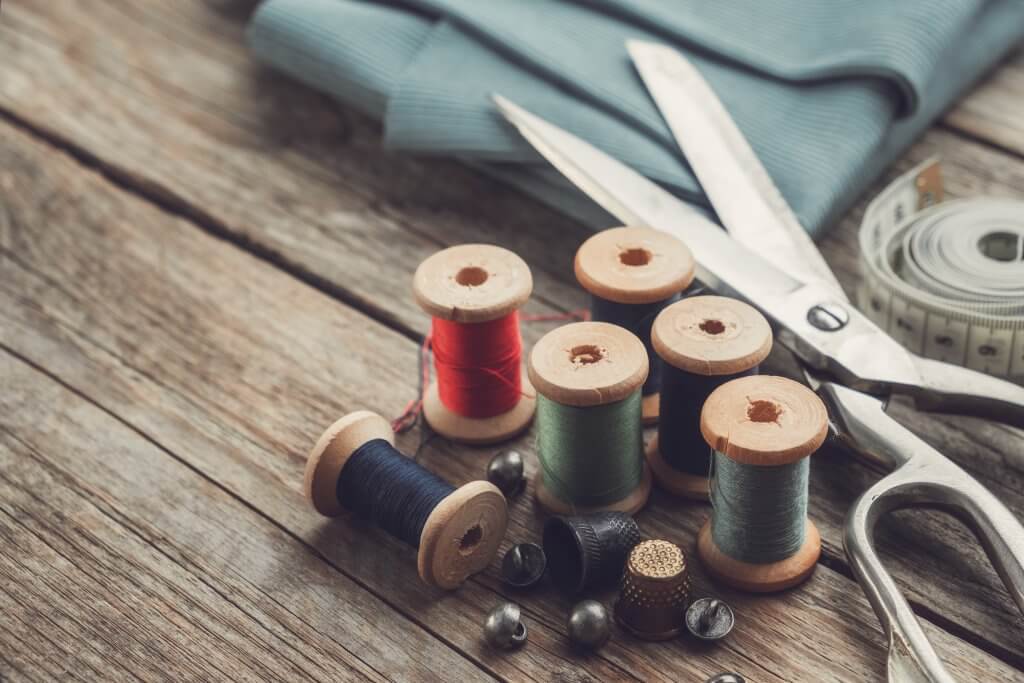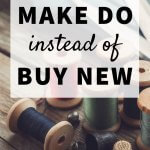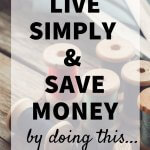As I was researching for a previous post on statistics on clutter, I became increasingly aware of how we live in a throw-away culture. It got me to thinking about when you should make do instead of buy new.

When You Should Make Do Instead of Buy New:
In a world where it is so easy to buy things with the simple click of a button, we have to be more intentional and purposeful with our choices.
It’s certainly convenient that I can have an Amazon box arrive in 2-days with almost anything I can think of. However, that doesn’t always make it the best option, especially if your goal is to simplify.
There are times where we should make do instead of buy new.
When you can’t afford it
There are many things we can easily buy that we cannot actually afford. Payment plans, loans, and credit cards all can enable us to live outside our means.
The problem is that eventually living that way will catch up with you. Overspending causes a great deal of stress. You carry a burden when you have ongoing debt.
Living outside of your means can strain marriages and other relationships. When you don’t have the money already saved for an item, then you can’t afford it yet. Choose instead to live within your means and wait to purchase.
Even if you can afford to purchase, it doesn’t mean you should. Saving money and choosing to live frugally is always a good idea.
When you want to be a more conscious consumer
As awareness continues to increase over waste perhaps you’re trying to be a more conscious consumer and make more responsible decisions.
We’re beginning to understand more where fast fashion has gotten us.
Between 2000 and 2015 clothing production doubled globally while the average number of times a piece of clothing was worn before disposal went down 36%. Second-hand stores and textile recyclers are struggling to keep up with the constant influx of unwanted clothing. (source)
While it’s great to donate responsibly, that is only one piece to the puzzle. We must also figure out how to decrease consumption. That means opting to buy new things less often and making do with what you already have.

When you want to live more simply
As you strive to live more simply, it’s important to increase your awareness of marketing messages. Question why you are tempted to shop and really ask yourself if that item would benefit your life or add to your clutter.
In a consumer culture that is constantly telling us to buy more, it isn’t easy to choose simplicity. But falling prey to advertising messages can land you in debt and in a house full of clutter.
I have found some products that have helped simplify my life, but certainly, many that claim to don’t and even a great product can become clutter if you never use it. Most of us already have significantly more than we need.
Check your motivations before making any purchases. Don’t use shopping as a coping mechanism. Focus on gratitude for what you already have and choose to make do instead of buy new.
When you want to clear the clutter
Once you’ve decluttered your home, the goal becomes not allowing clutter to continually re-enter the space. Part of that is working on shopping more intentionally.
Pay close attention to where clutter is coming from in order to maintain your newly decluttered space. Making do means working with what you’ve got and not constantly acquiring more.
Sometimes an item breaking beyond repair can be an unexpected blessing. At that point question whether or not you really need to replace that item.
Do you have something else that could do the job? Could you borrow it when it’s needed rather than buy another one?

How to make do instead of buy new
We’re so used to quickly and easily replacing or purchasing new items that it takes some thought to consider how to stop those habits and what to do instead.
Buy quality instead of cheap
Consider if the item you’re buying is a cheap throwaway item or if it will last the test of time. My husband and I sometimes debate whether or not more expensive equals higher quality. I don’t always think it does, but there is a lot of cheap garbage out there.
Dollar stores and discount stores have infused the market with a plethora of cheap plastic items. It is getting more challenging to find items that are of higher quality.
When you do buy things, buy smart. Try to find higher-quality pieces. If you’re frugal, like me, this might be a challenge for you. However, better quality items will be easier to make do with and repair later if needed.
You’ll find that many minimalists don’t gravitate towards the cheapest items. They want their minimal possessions to be items that are quality and that will last.
If your goal is to free yourself from the weight of your clutter, then continuing to buy poor quality items because they are inexpensive and basically expendable won’t help you get there.
Learn how or pay to repair
With the plethora of inexpensive items, many of which cannot be repaired, we have started to lose the art and expertise of knowing how to repair things.
In my grandparent’s generation people saved for higher quality items that they they valued. Those items then were maintained and repaired as needed and a lot of them lasted for many many years.
Clothes get worn, get a hole, and are often trashed. Since it’s easy to replace people don’t tend to take the time to fix clothing. And with some of the cheaper fabrics, it isn’t necessarily possible to repair it.
We’ve worked to try and repair what we can and make do with what we have. I repair any holes that I can (leggings are a challenge!) and get as much wear out of things as we can.
Our vacuum sprung some leaks in the hose this past summer. Sadly the company no longer carries repair parts for it. Otherwise, it was working fine so I didn’t want to replace it. We found stretchy silicone tape to repair the tears to continue to make do for now.
A few summers ago I bought a great pair of leather boots at a garage sale. I paid $8 for them and they were in new condition. That is until I got them and wore them constantly. I now pay a lot more than $8 to have them re-soled and kept them in good condition by taking them to a local cobbler.

Borrow
If you need to use something but don’t own it, consider checking with family, friends, neighbors, and community members before purchasing.
Maybe you can make do by burrowing the item instead of owning it. I’m thankful to live near my extended family. We co-own some items like a pressure washer. We also share tools. It’s a great way to own less but still have access to what we need only occasionally.
More cities are also getting tool libraries where items can be borrowed or rented. Buy Nothing groups can also be a great resource for this. It has the added benefit of getting to connect with people in your community as you also live more simply.
Buy secondhand
If you find you really want or need something and borrowing isn’t an option, buying secondhand is a great idea for many types of items.
Buying secondhand saves you money and it also means less waste.
There are many options for places to shop secondhand. Some of my favorites are secondhand are local thrift shops, Facebook marketplace, Craig’s list, and Offer Up.
Be creative
When all else fails, be creative. Think outside the box. Do you have something else that could serve the same function? How could you use what you already have?
I remember all through childhood receiving cards from my great grandmother that were half a card. She made do by reusing cards by cutting them in half.
They say that necessity is the mother of invention. Having lived through the Great Depression she figured out how to use her resources and we should too.
As you strive to live more simply or to save money, think of when and how you can make do instead of buy new.
Want to keep up to date on the latest Simplicity Habit information? Sign up below and also receive the 8 Quick Decluttering Wins checklist!



My partner is alway telling me to throw things away as I always saying I can repair that. I always looking for different uses for things. One great thing about the internet I actual spend the time researching before I buy.
Yeah but do you repair them in a reasonable amount of time or are they with a pile of stuff to be repaired?
Yesterday I bought three t shirts. I haven’t actually bought anything except 2 bras and 6 panties and 2 pairs of shoes since 2020. I had so much, it was Covid, then I had a shoulder operation, then there was our covid attack and then I had a stroke. And I had so many clothes. I still have lots of clothes! So I went through them and discarded anything that didn’t fit or I didn’t like any more. I still have so many clothes. But I really only wear tee shirts and pull-ups… tee shirts have gone into holes will be recycled into bath mats. My children love them.
I also used this time to go through our crockery etc. I gave away all the odds and ends. We have enough glasses for a lifetime. We don’t entertain much now. I have started giving dinner sets and glassware to the kids.
The books are the best. I am starting give them away. I read a book in 3 days. Then I put it into a bag. When the bag is full I either put it in the lobby for others to pick through, or gift it to somebody. But somehow the house is still awfully full of things…